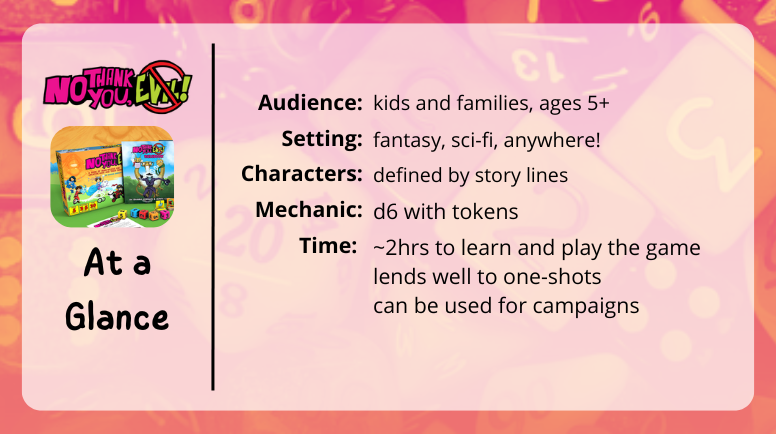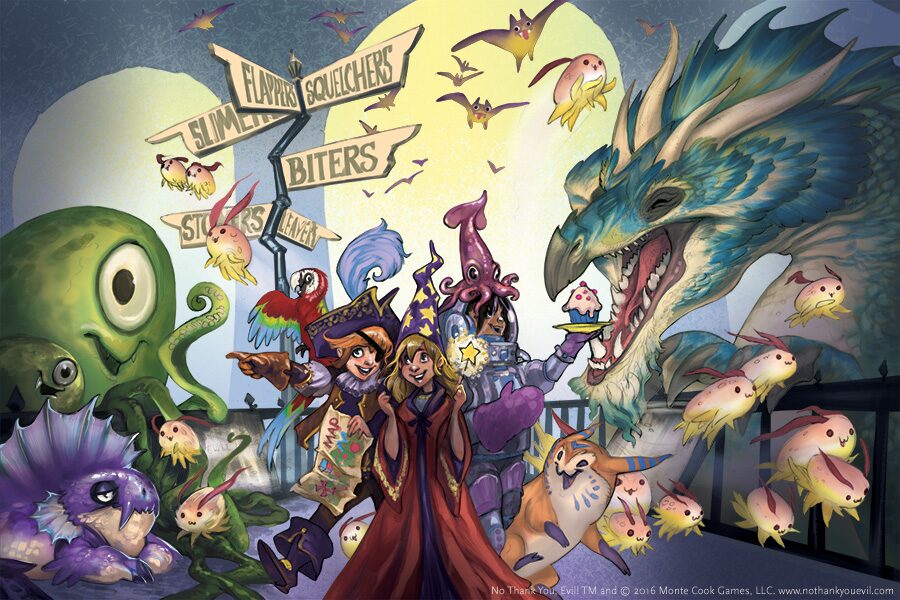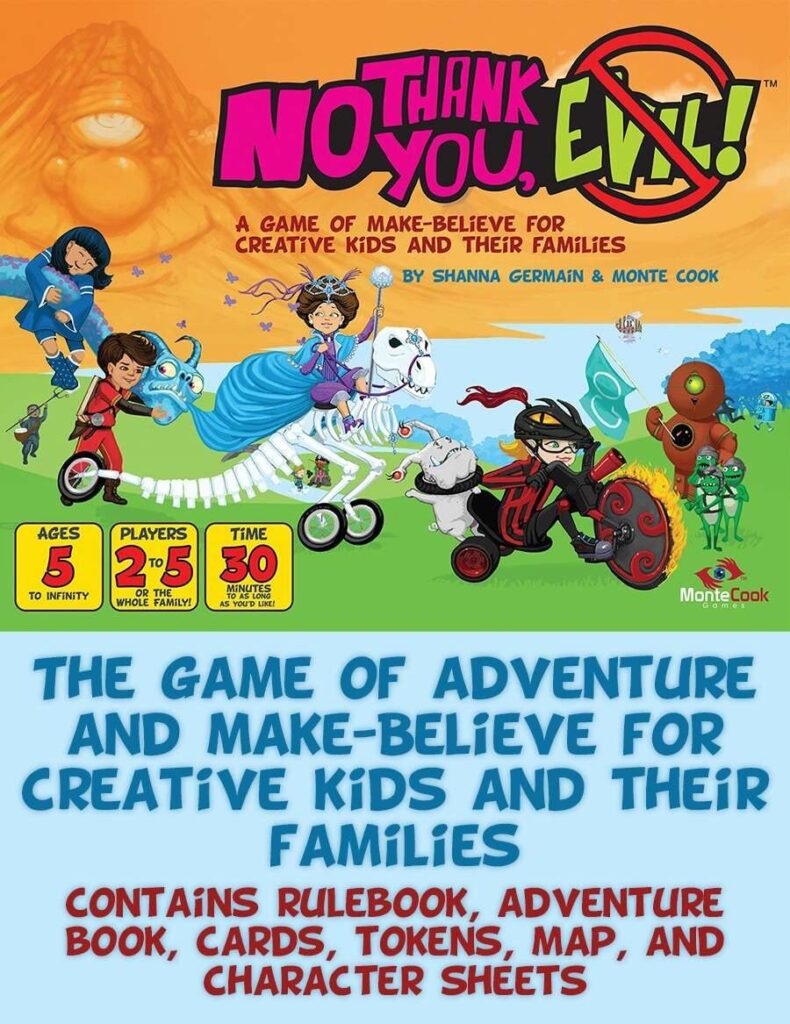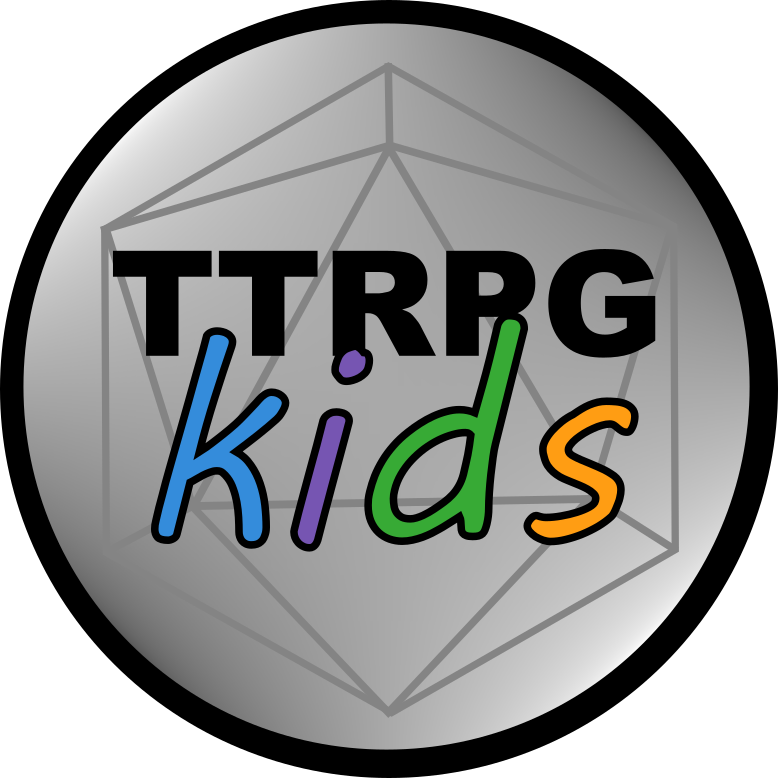Review of No Thank You, Evil!
I’ve been meaning to play and review No Thank You, Evil! for a long time now, and I finally got the chance at Gen Con! Thanks to some awesome adventure guiding that Kat the Dungeon Mom did for kiddo and a whole table of awesome players, we had a great time playing and are happy to share our take on it with you!
*This post may contain affiliate links. At no additional cost to you, I may earn a small commission from purchases made using them. TTRPGkids uses this to keep the site going. Read full disclosure here.
Jump to:
- Audience for No Thank You, Evil!
- Setting for No Thank You, Evil!
- Characters in No Thank You, Evil!
- Mechanics of No Thank You, Evil!
- Overall thoughts on No Thank You, Evil!
- Find a copy of No Thank You, Evil!

Audience for No Thank You, Evil!
No Thank You, Evil! is made for “creative kids and their families”, so EVERY element of this game is tailored to be accessible and engaging to new players AND for families to be able to play as a group.
This game’s target age is for players 5 and up, and I would say that it does the job – mechanics were easy for all kids at the table to follow, and for the GM to teach and assist with throughout the game. The adventures that come with the game all have some pretty kid-friendly vibes with options to confront a challenge in different ways – you can fight, talk, sneak, collaborate, and just get creative to tackle different encounters.
The stories are also things that kids are interested in (like how ours was a whacky space adventure) and/or the system just gives a base for building any kind of story from, allowing players and the guide to make it fit what they want. It’s not locked into one type of story.

Setting for No Thank You, Evil!
No Thank You, Evil! can work for any setting since the character building elements aren’t really tied to a list of particular spells, tech, or other artifacts that work only for a specific genre or two.
The premade adventures and characters span a wide range of story types, including fantasy and sci-fi, so there’s base content in multiple settings that can be built off of.
For the game we were in, we played a sci-fi adventure where we needed to explore a space ship that had gotten stuck on its way to its destination! There were critters to face, a puzzle in a secret lab, a computer riddle or two to decipher, and more that created an exciting session that everyone at the table was interested in and participated in.
Characters in No Thank You, Evil!
Characters in No Thank You, Evil! are built from statements that tell everyone what kind of abilities your character has.
For example, if my kid chooses “Link is a fast fighter”, that means that kiddo’s character, Link, is going to have some extra ability when it comes to speed and strength, but maybe not as much with smarts, since that wasn’t mentioned in the statement.

You’ll also have a knack and a talent that will give you some, probably slightly whacky, ability and can help you later. I thought of these as kind of like your two special actions or spells or pieces of gear that you would track instead of a full spell list or tome of moves.
I felt that this statement format with just a couple extra points to track did a few really cool things with the game and got players to immediately bond with their characters.
First, your character can be who you want. There’s LOTS of room for interpretation, and you aren’t limited to particular classes or types of characters. I mean, we were playing a space adventure, and kiddo chose to play Link from Legend of Zelda, and that worked (really well).
Second, your first focus is on who the character is instead of trying to game the mechanics. My kid knew they wanted to play Link and Link is fast and fights, so… we define that first and see how to get the mechanics to make that work out best.
Third is that it is easy to understand but has some scaling. There’s an option to add a verb to the phrase to expand your character a bit if you want to track more, but you don’t have to. Your character fits in this one short line that most players should be able to at least kind of read or write. It gives a really easy to track point to start role-playing from so that young kids aren’t trying to parse through tons of text.
Your character sheet will track a few extra things, like your stats, your stuff, and your companion, but we will get to that next…
Mechanics in No Thank You, Evil!

No Thank You, Evil! uses a modified version of Cypher System, parsing it into something that kids can readily use, so if you know Cypher, you’ll be familiar with a bit of the mechanics here, but if you don’t know it, the mechanics are designed to be easy to pick up for new players. There is always a little more to the game than what I can summarize in a post, so, for No Thank You, Evil!, I’m going to cover the core 1d6 and tokens mechanic for this review.

Your character has 4 stats, Tough, Fast, Smart, and Awesome, that act as pools of points for your adventure. You can pay these tokens on an applicable 1d6 roll to improve your odds of success. This is also how you take damage; if you’re hit with a space laser, you might lose a Tough token, meaning you can’t spend it to improve your odds later.
You’ll also be able to get some help with rolls by using your knack or talent OR from getting assistance from your companion! You have a companion who can help you out, and they’re defined by a sentence (like “Wolf Link is brave”) that will define how they will be RP’d as well. Each player has a certain number of treats that they can use to “activate” help from their companion.
One of my favorite mechanics here was the Awesome stat. While Tough, Fast, and Smart are directly aligned with the roll the player is making, Awesome is about helping others. If you see that another player is trying to make a tough roll, you can give them an Awesome token to further help them improve their odds or making it. This is GREAT for teamwork as there’s no disadvantage to the player giving the token (the ONLY thing that it can be used for is to help others) so you get players giving each other help pretty freely, and that just feels good.
When it comes down to it, the mechanics revolve around needing to make a 1d6 die roll against a target number, but you can pay token from a variety of sources (stat tokens, your companion’s treats, awesome tokens from other players) to add points to your roll and help meet the target. It’s a clever and tactile way to allow players to strategize and team up while still being able to track everything (due to it being represented by physical tokens), giving that balance of keeping players of various ages challenged while still staying accessible to young and new players.
Overall thoughts on No Thank You, Evil!
Kiddo LOVED this, and I, despite being a bit zonked out from GenCon chaos at the time we were playing, was able to fully follow along with the rules and story and enjoy my time watching at the table as Kat the Dungeon Mom led the group.
I liked how quickly everyone was able to get their characters set up and how both kids and adults were invested in the story. I think mechanics like the Awesome pool help establish that it is collaborative and that, even if you really don’t want to be in the middle of the action all the time, you’re still there and helping and have options.
Overall, it’s a great system that works for young players, draws people into the group, and keeps the excitement going throughout the whole adventure.
Find a copy of No Thank You, Evil!
You can find a copy of No Thank You, Evil! on the Monte Cook website and DriveThruRPG

If you liked this post, make sure to subscribe to the TTRPGkids monthly newsletter to stay up to date on the latest reviews, tips and tricks, game and podcast list updates, and more! Thank you for playing tabletop RPGs with your kids and sharing this awesome hobby with the next generation!


